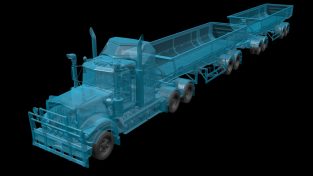Public transport networks are complex. An error or delay in one segment can cause a ripple effect down the line. In this episode of Location Intelligence, we talk to VBZ, the public transport operator in Zürich, about how it uses Hexagon’s geospatial solutions to optimize transportation efforts across the city.
JD: Hi, thanks for tuning in to Location Intelligence on HxGN Radio. I’m your host, Justin Dinger. Public transport networks are complex. An error or delay in one segment can cause a ripple effect down the line, for the transport provider and the public. To manage this complexity, most transportation agencies rely on different, disconnected data sources spread across multiple systems, departments, and formats.
Typically, this data can’t be viewed in real-time, making it difficult to gain a holistic view of the network’s asset conditions to coordinate maintenance activities, plan for new projects. Fortunately, there are solutions that allow public transit organisations to manage their data, workflows and transit networks more efficiently, by combining asset and spatial data into an integrated network for sharing accurate and up-to-date information.
In this episode, I’m talking to Timon Zueger, head of the GIS division at VBZ, the public transport operator in Zurich and Dr. Nadia Panchaud, Services Team Lead at Hexagon’s Safety, Infrastructure & Geospatial division in Switzerland. We’ll discuss how the right geospatial solutions helped VBZ optimise its transportation efforts in Zurich and more. Timon and Nadia, welcome to the show.
TZ: Hi Justin, thanks for the invitation.
NP: Thank you, Justin. Happy to be here.
JD: Great. So, let’s dive in. Timon, please tell us about VBZ and your role at the agency.
TZ: We are a public transport operator, transporting people from A to B. Our fleet includes both, street cars and buses. What makes our company special is that we not only operate the network, but also plan, build and maintain it. My function at VBZ, is on the one hand, to keep our GIS systems fit and to develop them further. On the other hand, I’m responsible for the programme management of BIM. Further, I’m also involved in the innovation management of VBZ.
JD: Great. And so overall, tell us about the transportation management challenges that you all are working to overcome in Zurich.
TZ: We are not alone in the city, which means that we always must take into account the citizens, as well as other departments of the city, when building and maintaining our infrastructure. When we build, we sometimes cannot avoid a total closure. So, we must plan as precisely as possible to be able to work efficiently so that traffic is not interrupted for too long. Disruption on the network, such as broken rails must be detected in advance, so that it affects our fans, how we like to call our passengers, as little as possible. Another challenge is that our network is getting busier and busier, but the resource for maintenance remain the same.
JD: So, Nadia, please tell us… I know you’ve been working with VBZ for a while. Tell us how Hexagon’s transportation solutions and the value that they offer to the public transit organisations.
NP: Yes, so Hexagon Public Transportation Solution helps transit organisation to manage their data, workflows and networks efficiently. Our solution gives them and their teams access to accurate and up-to-date information, by combining assets and spatial data into one integrated network. Built with the newest technologies including 3D and AI capabilities, it goes beyond a simple map. And it provides an advanced digital twin of a public transit organisation’s network, from tracks and stop to tickets, machines and information group.
Thanks to Hexagon solution, every team in the organisation can have access to the data, maps and reports and this, without relying on GIS specialists. It may be for editing the data, inspecting the infrastructure, or sharing data with the public or with governmental agencies. For instance, maintenance workers can enter the observation and repair works directly into the system via a mobile application, which gives them access to the data directly in the field. There’s no more paper sheet from the field that need to be tediously entered in the system, once back at the desk. Moreover, our public transportation solution comes with spatial temporal dashboards, that provide executive management with accurate and up-to-date information about state of the network.
In short, we help streamlining the digitalisation of all assets pertaining to the network of the public transit organisation. And we support them in creating a real digital twin of their infrastructure.
JD: Thank you, Nadia. Timon, let’s dive a bit deeper into VBZ’s use of our solutions. Why did you all choose this solution? And what were the overall goals when it was implemented? And are there any key milestones that you can share?
TZ: Before using our current solution, our system was based on CAD plans. By switching to a database-based solution, we wanted to increase the confidence in our data. We were looking for a solution that would enable us to streamline our processes by automating tasks. One of the main goals was to have one leading system for our inventory data. The system should allow, used to quickly generate reports for the federal, cantonal or municipal governments, as well as for other stakeholders. All in all, we wanted to be ready for the future. Thanks to Hexagon’s solution, most of our requirements were met. Some goals have been postponed to a GIS, 2.0 project. With this Hexagon solution, our data delivery is completely automated. The inventory data are obtained exclusively through to our GIS. We have our data management under control and are able to improve our data quality in collaboration with partners.
JD: So that’s really great. I have another question. So could you please tell us more about how you all use this solution and are there any examples of successful workflows or processes, that you all have been able to achieve with our solutions?
TZ: Yes, of course, one case is for project planning, where data is exported from the GIS for the CAD engineering tool. Our project planners get their information from the GIS and the process is automatic. New projects are implemented in the GIS. New projects are implemented in a database, not only in the drawing system. As a result of the database-based work, errors in the data are detected much faster. Another example is that through FME interfaces, we can use our inventory data with GIS to BIM (Building Information Modelling) and GIS to AR (Augmented Reality) in a versatile way and also control its quality.
JD: Wow. I think that integration of BIM and AR is really cool stuff. What are some of the overall successes that you all have been able to achieve? I’m thinking, are there any quantitative or qualitative results, like time or cost savings or customer satisfaction rates? Do you guys have any of that stuff you could share?
TZ: Yes. The success is quite impressive. Thanks to process optimisation and automation, we are able to save about one full time position. Because we switched to a database, our up-to-date data is available for everyone involved. Another level, we’re linking to various other systems. The understanding of data management has grown within the company. This then leads to an increased efficiently among staff.
JD: Timon. Thank you. Nadia, I’m going to pivot to you for this next question. From Hexagon’s perspective, why is this implementation important, and how can these successes be relevant for other global transit systems and agencies?
NP: Well, Justin for VBZ we had to integrate and structure data from different sources and in different formats into our solution. And it showed first the customer how scattered their data were, and how out solution was already helping them to get the more complete picture of their work, all accessible in one place and then saving them valuable time. And then the internal processes of the VBZ, they required several import and export interfaces through the systems, to streamline and automate their integration of the data sources into the solution. And it showed how flexible and powerful a solution is, when it goes about connecting information streams from various division, which work with different technology. So, it further underlined the strength of our solution, with its customisation potential, and because we could meet the specific customer needs in that project really easily.
So for us, it was also a great opportunity to get valuable and continuous feedback directly from the users, and this feedback we could incorporate it into the ongoing development of the product.
JD: So Timon, what advice would you give to other global transportation operators, that are looking to better modernise and streamline their transportation efforts?
TZ: Yes, of course. I like this question. Don’t underestimate change management. Culture change is the biggest challenge. Additionally, you should define your requirements for the system very precisely. Goals should be measurable and written in a way that are understandable to all people involved.
JD: And so, looking forward to moving forward, what are VBZ’s overall future strategic goals? And what are your plans for expanding the use of this solution across the network in the city of Zurich?
TZ: The topic of BIM is pushing more and more into GIS, and it’ll be a greater focus for us. GIS will certainly play a leading role in the context of BIM. At the same time, we started the project GIS 2.0, which aims at migration the last remaining system inventory data in our GIS database. In order to make the GIS system even more attractive for users.
JD: Nadia, are there any insights to share about Hexagon’s future plans when it comes to transportation?
NP: Yeah, sure. So, one of the next hot topic is the integration of 3D data, point cloud and 3D mesh data already possible. But there is still lots of potential in this area for further functionalities, to help public transportation sectors streamline the processes. For instance, linking the point cloud data with the attributes coming from the traditional spatial data, as well as the integration of BIM data. And coming up next is also the use integration of live data into the solution, such as the positioning of the vehicle or streams of customers. But also, the wider use of AI to automate processes such as in the area of predictive maintenance.
JD: Interesting stuff. So, it’s being able to read IoT sensors in real-time across the network and integrate things like that, correct?
NP: Yes, exactly.
JD: Great. So, as we bring this podcast to a close, I ask all my guests, are there any closing thoughts or ideas you’d like to share with the audience? And are there any key takeaways that they should think about from listening to this conversation?
TZ: GIS has become deeply integrated into our society in the recent years. In the construction sector, where we mainly need GIS, new trends and digitalisation topics or immersion. GIS can use this opportunity to position itself even stronger. An opportunity that should be taken. The GIS tools by Hexagon have all the functions needed to manage a public transport infrastructure. However, good tools are not everything. People have to be ready to work with the tools. Do not underestimate the change management within your company. In the future, much will change in the construction sector with BIM, from which GIS is also affected and can benefit greatly.
NP: That’s true. And I would say that the main strength of Hexagon’s transportation solution is its ability to integrate data from various sources to create a digital twin of the network. It offers a complete up to date and accurate view of the whole system, all in one place. Which brings numerous operative advantages and saves valuable time across the organisation. This means that our solution is well prepared to seize the opportunities that Timon mentioned before.
JD: Great. Thank you, Nadia and thank you, Timon. I’d like to say a big thank you to Timon and Nadia, and if we’re able to have you all back on in the future, that would be great. As VBZ continues to go after their GIS 2.0 projects, if there’s any updates that you all would love to share, we would really like to have you back on the show.
TZ: Thank you, Justin, for the invitation. And of course, see you again.
JD: All right.
NP: Thank you, Justin and with pleasure.
JD: Of course, Nadia. All right. Thank you for tuning in to Location Intelligence on HxGN Radio. For more great stories and podcasts, visit hxgnspotlight.com.
















